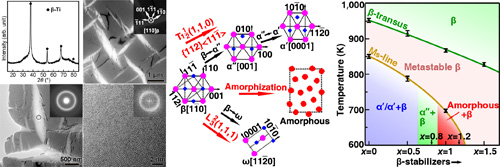Solid-state amorphization (SSA), i.e. the transformation from a crystalline phase to an amorphous phase, is an alternative process, besides the fast quenching of molten liquids, to obtain amorphous phases.
Recently, Prof. ZHANG Haifeng’s team from Institute of Metal Research, Chinese Academy of Sciences discovered a new kind of SSA—Martensitic Transformation-Induced Amorphization.
During investigating phase transformations in the as-solidified (Ti0.615Zr0.385)100-3.9x(Cu2.3Fe1.6)x (x=1) alloy, researchers found lenticular or lathy amorphous regions embedded in metastable β-Ti grains with the long axes along specific crystallographic directions.
No obvious compositional difference can be detected in the amorphous regions and the β phase matrix, and many shear steps and severe lattice distortion of β phase are found at the interfacial region between the amorphous region and the β-Ti matrix. Such morphology of the current amorphous phase is clearly different with the previously reported SSA mechanisms.
A mechanism of Martensitic Transformation-Induced Amorphization is proposed: Upon cooling of metastable β-type (Ti0.615Zr0.385)100-3.9x(Cu2.3Fe1.6)x alloys, the body-centered cubic (β) phase, which is the phase in equlibrium at high temperatures, becomes unstable gradually. Two phonon anomalies, T1 1/2 (1,1,0) and L 2/3 (1,1,1) occur. The former transforms β phase to α¢/α¢¢ martensite, and the latter causes the shuffle of partial {222}β planes to form ω phase.
In the special case of β-Ti alloys with certain compositions, the local lattice shear and distortion during martensitic transformation make the structural-disordered amorphous phase prone to form as compared with the formation of crystalline α¢/α¢¢/ω phases, i.e. the martensitic amorphization happens. The current intragranular amorphous phase could be named as “Amorphous Martensite”.
This work was published online in Nature Communications on Feb. 6th, 2018.

Figure. Microstructure, amorphization mechanism, and metastable phase diagram of (Ti0.615Zr0.385)100-3.9x(Cu2.3Fe1.6)x alloys (Image by IMR)
Contact
HUANG Chengyu
Institute of Metal Research
E-mail:cyhuang@imr.ac.cn